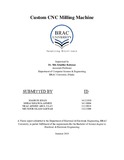| dc.contributor.advisor | Rahman, Dr. Md. Khalilur | |
| dc.contributor.author | Khan, Masrur | |
| dc.contributor.author | Ahmed, Meraj Khawja | |
| dc.contributor.author | Ulay, Neaz Ahmed Abul | |
| dc.contributor.author | Sarwar, Md. Noor Islam | |
| dc.date.accessioned | 2018-12-26T06:52:19Z | |
| dc.date.available | 2018-12-26T06:52:19Z | |
| dc.date.copyright | 2018 | |
| dc.date.issued | 2018 | |
| dc.identifier.other | ID 14121030 | |
| dc.identifier.other | ID 14110004 | |
| dc.identifier.other | ID 13110018 | |
| dc.identifier.other | ID 13221009 | |
| dc.identifier.uri | http://hdl.handle.net/10361/11052 | |
| dc.description | This thesis is submitted in partial fulfilment of the requirements for the degree of Bachelor of Science in Electrical and Electronic Engineering, 2018. | en_US |
| dc.description | Catalogued from PDF version of thesis. | |
| dc.description | Includes bibliographical references( page 41-42). | |
| dc.description.abstract | Computer Numerical Control or CNC Machines are integral in shaping complex layouts into physical products. The plotting mechanism of such machines comprise of very fine accuracy that is never humanly possible to create. In Bangladesh, various types of products from raw materials like wood, copper board or fabric involve the use of CNC machines for industrial production. However, like the problems in most developing countries, the use of such machines require technical expertise, especially for repairs or modifications and this country has lack of such engineers and technicians. Also, these are mainly imported from abroad and the required software to operate such machines is proprietary which adds more to the cost. These issues have been the country's long term problem in the industrial sector. For an innovative solution, this paper discusses about the concept of building a CNC machine with a more cost-effective approach and available resources. This includes the use of open source software as an alternative to proprietary software in order to make the CNC machine operations easier to understand for the average engineer. Initially, a prototype and then a final structure has been built, based on that prototype design for printing and milling applications, where the final structure printed with about 60% accuracy. | en_US |
| dc.description.statementofresponsibility | Masrur Khan | |
| dc.description.statementofresponsibility | Meraj Khawja Ahmed | |
| dc.description.statementofresponsibility | Neaz Ahmed Abul Ulay | |
| dc.description.statementofresponsibility | Md. Noor Islam Sarwar | |
| dc.format.extent | 42 pages | |
| dc.language.iso | en | en_US |
| dc.publisher | BRAC University | en_US |
| dc.rights | BRAC University theses are protected by copyright. They may be viewed from this source for any purpose, but reproduction or distribution in any format is prohibited without written permission. | |
| dc.subject | Milling machine | en_US |
| dc.subject | CNC | en_US |
| dc.title | Custom CNC milling machine | en_US |
| dc.type | Thesis | en_US |
| dc.contributor.department | Department of Electrical and Electronic Engineering, BRAC University | |
| dc.description.degree | B. Electrical and Electronic Engineering | |

